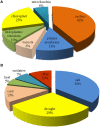Subcellular protein overexpression to develop abiotic stress tolerant plants
- PMID: 23346093
- PMCID: PMC3549530
- DOI: 10.3389/fpls.2013.00002
Subcellular protein overexpression to develop abiotic stress tolerant plants
Abstract
Environmental stresses are major factors limiting growth and development of crops. Plants respond to the stresses through a wide range of reactions from morphological changes to alterations in the patterns of protein expression. Understanding the mechanisms involved in the stress response is the first step to develop abiotic stress tolerant crops. Proteomics is a powerful tool in evaluating regulated proteins in the cell under stress and it is an efficient technique in studying stress tolerant plants. Because of the nature of abiotic stress, intracellular compartments play a main role in the stress response. Subcellular proteins such as ion and water transporters, reactive oxygen species (ROS) scavengers, and the proteins related to signaling and transcriptional regulation are frequently reported as being involved in stress tolerance. Overexpression of stress-responsive protein through generation of transgenic plants is one the main practical approaches in production of tolerant plants. In this article, recent studies on transgenic plants overexpressing subcellular proteins are reviewed and the role of organelles and over-expressed proteins is classified.
Keywords: abiotic stress; overexpression; subcellular protein; transgenic.
Figures
Similar articles
-
Abiotic stress-induced anthocyanins in plants: Their role in tolerance to abiotic stresses.Physiol Plant. 2021 Jul;172(3):1711-1723. doi: 10.1111/ppl.13373. Epub 2021 Mar 1. Physiol Plant. 2021. PMID: 33605458 Review.
-
Stress Tolerance Profiling of a Collection of Extant Salt-Tolerant Rice Varieties and Transgenic Plants Overexpressing Abiotic Stress Tolerance Genes.Plant Cell Physiol. 2015 Oct;56(10):1867-76. doi: 10.1093/pcp/pcv106. Epub 2015 Sep 1. Plant Cell Physiol. 2015. PMID: 26329877
-
Subcellular Proteomics to Elucidate Soybean Response to Abiotic Stress.Plants (Basel). 2023 Aug 4;12(15):2865. doi: 10.3390/plants12152865. Plants (Basel). 2023. PMID: 37571018 Free PMC article. Review.
-
Plant cell organelle proteomics in response to abiotic stress.J Proteome Res. 2012 Jan 1;11(1):37-48. doi: 10.1021/pr200863r. Epub 2011 Nov 16. J Proteome Res. 2012. PMID: 22029473 Review.
-
Overexpression of AtOxR gene improves abiotic stresses tolerance and vitamin C content in Arabidopsis thaliana.BMC Biotechnol. 2016 Oct 7;16(1):69. doi: 10.1186/s12896-016-0299-0. BMC Biotechnol. 2016. PMID: 27717369 Free PMC article.
Cited by
-
Emerging tools, concepts and ideas to track the modulator genes underlying plant drought adaptive traits: An overview.Plant Signal Behav. 2016;11(1):e1074370. doi: 10.1080/15592324.2015.1074370. Plant Signal Behav. 2016. PMID: 26618613 Free PMC article. Review.
-
Application of proteomics for improving crop protection/artificial regulation.Front Plant Sci. 2013 Dec 19;4:522. doi: 10.3389/fpls.2013.00522. eCollection 2013. Front Plant Sci. 2013. PMID: 24391656 Free PMC article. No abstract available.
-
Tissue-specific transcriptomic analysis reveals the molecular mechanisms responsive to cold stress in Poa crymophila, and development of EST-SSR markers linked to cold tolerance candidate genes.BMC Plant Biol. 2025 Mar 19;25(1):360. doi: 10.1186/s12870-025-06383-3. BMC Plant Biol. 2025. PMID: 40102740 Free PMC article.
-
Time-dependent leaf proteome alterations of Brachypodium distachyon in response to drought stress.Plant Mol Biol. 2017 Aug;94(6):609-623. doi: 10.1007/s11103-017-0628-2. Epub 2017 Jun 24. Plant Mol Biol. 2017. PMID: 28647905
-
The drnf1 Gene from the Drought-Adapted Cyanobacterium Nostoc flagelliforme Improved Salt Tolerance in Transgenic Synechocystis and Arabidopsis Plant.Genes (Basel). 2018 Sep 4;9(9):441. doi: 10.3390/genes9090441. Genes (Basel). 2018. PMID: 30181517 Free PMC article.
References
-
- Aharon R., Shahak Y., Wininger S., Bendov R., Kapulnik Y., Galili G. (2003). Overexpression of a plasma membrane aquaporin in transgenic tobacco improves plant vigor under favorable growth conditions but not under drought or salt stress. Plant Cell 15, 439–447 10.1105/tpc.009225 - DOI - PMC - PubMed
-
- Bartels D., Sunkar R. (2005). Drought and salt tolerance in plants. Crit. Rev. Plant Sci. 24, 23–58
LinkOut - more resources
Full Text Sources
Other Literature Sources


